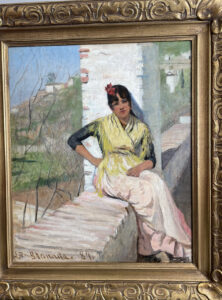 EF, who receives my monthly “Stuff-Whisperer” newsletter, read that I visiting my brother in Malaga, Southern Spain the first two weeks of September. Because I experienced Andalusian culture recently she sent an oil on canvas of her “Spanish Lady,” as her family calls it, dated 1887.
EF, who receives my monthly “Stuff-Whisperer” newsletter, read that I visiting my brother in Malaga, Southern Spain the first two weeks of September. Because I experienced Andalusian culture recently she sent an oil on canvas of her “Spanish Lady,” as her family calls it, dated 1887.
EF’s grandparents purchased it at my favorite department store growing up in Chicago. They paid $67 at Marshall Field and Co. after their wedding in 1915. EF remembers it in their dining room.
We call this style of work “genre painting.” These images portray the ‘old world’ of simple people in traditional costumes, set in streets hundreds of years old, exotic, and uncomplicated. The subjects portrayed display a natural dignity born of the old ways of their native lands.
Two Themes of Genre Painting
Genre painting took the form of one of two prevalent themes in art of the Gilded Age (1870-1900). As I suggested, some pictures show humble peons set in exotic places. The other theme pictured aristocrats set in the formal architecture of past ages. These two themes both looked ‘backward,’ either to a rural simpler past, or to idealized historical images of great status and refinement.
At the time of this painting (1887), the unknown artist “looked back” to old Spain. They imagined a pretty Andalusian maiden in traditional garb posed coquettishly on the walls of the streets of Granada. This genre style of the late 19th century felt “comfortable” in an era that seemed to move quickly into a confusing future. So the modern world felt imminently here to stay seemed unmistakable to people of the Gilded Age. Thus nostalgia for the uncomplicated past became a common theme in art, and architecture as well.
The Gilded Age A Time of Sweeping Changes
From 1870 to 1900 the US and developed countries of Europe transformed from agrarian societies of farmers and small producers to an industrial economy based in large cities. During these few short decades, innovation exploded in the fields of engineering, chemistry, and technology. This changed the pace and experience of life itself. People found the past easier to understand. This era, called the “Second Industrial Revolution” (1870-1914), became a technical revolution countered in art by nostalgic themes, retreating to the idealized past.
The modern world developed in the late 19th century with breakneck speed. Here’s a short list of inventions around the date of this painting: the telephone (1875), the incandescent light bulb (1879), the phonograph, the internal combustion engine, the electric generator, the Bessemer process for the mass production of steel, the air brake, the automobile (1886), the Kodak camera (1888), and the electric street car (1888).
Politically the world fell into turmoil with three great wars: the Franco-Prussian War (1870-1871), the Russo-Turkish Was (1877-1878), and the War of the Pacific (1879-1884). Late 19th century buyers of art purchased paintings, alleviating the fear of the future, like EF’s “The Spanish Lady” of 1887.
The “School” of “The Spanish Lady”
The painting is signed “Granada” bottom left, which isn’t the artist’s name, but the place. The lack of signature also indicates genre work, often not signed as that meant an anonymous (past) artist of the people. Signatures designated more highbrow works of art!
The “Granada School” or “Andalusian School” of the late 19th century featured handsome town and country folk. Very few images depicted nature in favor of classic “old world” village streets of Southern Spain. Images of an idealized lifestyle were painted in rich colors. Very few realistically painted figures appeared identifiable portraits.
Possibly the greatest artist of the Granada School was Manuel Garcia y Rodriguez. EF might compare his “A Street in Granada” of 1870 to her “Spanish Lady.”
I found works of the “Granada School” selling at the Galeria de Arte y Antiguedades Ruiz Linares in Granada. They offered a “Portrait of a Young Spanish Man” from the late 19th century for $1,450. I checked the Drouot Auction in Paris, the largest public auction consortium since 1852. They sold a work of the late 19th century Andalusian School attributed to A Martin/E Castar titled “Rebecca,” a Spanish version of “Rebecca at the Well,” for $1,500. Also, for comparable sales, at the Isbilya Auction House in Madrid, a fine example of a genre scene, a painting of ruffians titled “Bandoleros” sold for $1,000.
EF, your grandparent’s painting is likely worth $1,500-$2,000 today.